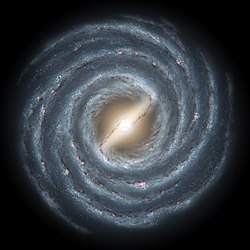Sextans-Zwerggalaxie
| Galaxie Sextans-Zwerggalaxie | |
|---|---|
| AladinLite | |
| Sternbild | Sextant |
| Position Äquinoktium: J2000.0, Epoche: J2000.0 | |
| Rektaszension | 10h 13m 02,9s[1] |
| Deklination | -01° 36′ 53″ [1] |
| Erscheinungsbild | |
| Morphologischer Typ | dSph[1]/dE3[2] [1] |
| Helligkeit (visuell) | 10,4 mag [1] |
| Winkelausdehnung | 30,0′ × 12,0′ [1] |
| Physikalische Daten | |
| Zugehörigkeit | Lokale Gruppe |
| Radialgeschwindigkeit | (224 ± 2) km/s [1] |
| Entfernung | (290.000 ± 30.000) Lj / (90.000 ± 10.000) pc [3] |
| Geschichte | |
| Entdeckung | Mike Irwin, M.T. Bridgeland, P.S. Bunclark und R.G. McMahon[1] |
| Entdeckungsdatum | 1990[1] |
| Katalogbezeichnungen | |
| PGC 88608 • | |
Die Sextans-Zwerggalaxie ist eine spheroidale Zwerggalaxie (dSph). Sie wurde 1990 von den Astrophysikern Mike Irwin, M.T. Bridgeland, P.S. Bunclark und R.G. McMahon als achte Satellitengalaxie der Milchstraße im Sternbild des Sextanten entdeckt[2][4].
Eigenschaften
Die auch als dE3[2] klassifizierte Zwerggalaxie entfernt sich mit Geschwindigkeit von 224 km/s von der Milchstraße und zeigt eine entsprechende Rotverschiebung. Die Galaxie hat eine Entfernung von etwa 290.000 Lichtjahren[1] von unserem Sonnensystem.
Weiteres
- Liste der Satellitengalaxien der Milchstraße
- Liste der Galaxien der Lokalen Gruppe
Einzelnachweise
- ↑ a b c d e f g h i NASA/IPAC EXTRAGALACTIC DATABASE
- ↑ a b c Sextans Dwarf. Abgerufen am 11. Juni 2009.
- ↑ Karachentsev, I. D.; Kashibadze, O. G.: Masses of the local group and of the M81 group estimated from distortions in the local velocity field. In: Astrophysics. 49, Nr. 1, 2006, S. 3–18. bibcode:2006Ap.....49....3K. doi:10.1007/s10511-006-0002-6.
- ↑ M. J. Irwin, P. S. Bunclark, M. T. Bridgeland, R. G. McMahon, R. G., Bunclark, Bridgeland, McMahon: A new satellite galaxy of the Milky Way in the constellation of Sextans. In: Monthly Notices of the Royal Astronomical Society. 244, 1990, S. 16–19. bibcode:1990MNRAS.244P..16I.
Weblinks
Auf dieser Seite verwendete Medien
Caption from NASA: Like early explorers mapping the continents of our globe, astronomers are busy charting the spiral structure of our galaxy, the Milky Way. Using infrared images from NASA's Spitzer Space Telescope, scientists have discovered that the Milky Way's elegant spiral structure is dominated by just two arms wrapping off the ends of a central bar of stars. Previously, our galaxy was thought to possess four major arms.
This artist's concept illustrates the new view of the Milky Way, along with other findings presented at the 212th American Astronomical Society meeting in St. Louis, Mo. The galaxy's two major arms (Scutum-Centaurus and Perseus) can be seen attached to the ends of a thick central bar, while the two now-demoted minor arms (Norma and Sagittarius) are less distinct and located between the major arms. The major arms consist of the highest densities of both young and old stars; the minor arms are primarily filled with gas and pockets of star-forming activity.
The artist's concept also includes a new spiral arm, called the "Far-3 kiloparsec arm," discovered via a radio-telescope survey of gas in the Milky Way. This arm is shorter than the two major arms and lies along the bar of the galaxy.
Our sun lies near a small, partial arm called the Orion Arm, or Orion Spur, located between the Sagittarius and Perseus arms.



